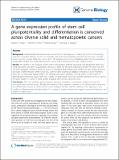| dc.contributor.author | Berger, Bonnie | |
| dc.contributor.author | Palmer, Nathan Patrick | |
| dc.contributor.author | Schmid, Patrick Raphael | |
| dc.contributor.author | Kohane, Isaac | |
| dc.date.accessioned | 2012-10-04T19:55:22Z | |
| dc.date.available | 2012-10-04T19:55:22Z | |
| dc.date.issued | 2012-08 | |
| dc.date.submitted | 2012-08 | |
| dc.identifier.issn | 1474-7596 | |
| dc.identifier.issn | 1465-6906 | |
| dc.identifier.uri | http://hdl.handle.net/1721.1/73622 | |
| dc.description.abstract | Abstract Background Understanding the fundamental mechanisms of tumorigenesis remains one of the most pressing problems in modern biology. To this end, stem-like cells with tumor-initiating potential have become a central focus in cancer research. While the cancer stem cell hypothesis presents a compelling model of self-renewal and partial differentiation, the relationship between tumor cells and normal stem cells remains unclear. Results We identify, in an unbiased fashion, mRNA transcription patterns associated with pluripotent stem cells. Using this profile, we derive a quantitative measure of stem cell-like gene expression activity. We show how this 189 gene signature stratifies a variety of stem cell, malignant and normal tissue samples by their relative plasticity and state of differentiation within Concordia, a diverse gene expression database consisting of 3,209 Affymetrix HGU133+ 2.0 microarray assays. Further, the orthologous murine signature correctly orders a time course of differentiating embryonic mouse stem cells. Finally, we demonstrate how this stem-like signature serves as a proxy for tumor grade in a variety of solid tumors, including brain, breast, lung and colon. Conclusions This core stemness gene expression signature represents a quantitative measure of stem cell-associated transcriptional activity. Broadly, the intensity of this signature correlates to the relative level of plasticity and differentiation across all of the human tissues analyzed. The fact that the intensity of this signature is also capable of differentiating histological grade for a variety of human malignancies suggests potential therapeutic and diagnostic implications. | en_US |
| dc.description.sponsorship | National Institutes of Health (U.S.) (R01GM081871) | en_US |
| dc.description.sponsorship | National Institutes of Health (U.S.) (R01LM010125-02) | en_US |
| dc.description.sponsorship | National Institutes of Health (U.S.) (U54-LM008748) | en_US |
| dc.publisher | BioMed Central Ltd | en_US |
| dc.relation.isversionof | http://dx.doi.org/10.1186/gb-2012-13-8-r71 | en_US |
| dc.rights | Creative Commons Attribution | en_US |
| dc.rights.uri | http://creativecommons.org/licenses/by/2.0 | en_US |
| dc.source | BioMed Central Ltd | en_US |
| dc.title | A gene expression profile of stem cell pluripotentiality and differentiation is conserved across diverse solid and hematopoietic cancers | en_US |
| dc.type | Article | en_US |
| dc.identifier.citation | Genome Biology. 2012 Aug 21;13(8):R71 | en_US |
| dc.contributor.department | Massachusetts Institute of Technology. Computer Science and Artificial Intelligence Laboratory | en_US |
| dc.contributor.department | Massachusetts Institute of Technology. Department of Mathematics | en_US |
| dc.contributor.mitauthor | Palmer, Nathan Patrick | |
| dc.contributor.mitauthor | Schmid, Patrick Raphael | |
| dc.contributor.mitauthor | Berger, Bonnie | |
| dc.contributor.mitauthor | Kohane, Isaac | |
| dc.relation.journal | Genome Biology | en_US |
| dc.eprint.version | Final published version | en_US |
| dc.type.uri | http://purl.org/eprint/type/JournalArticle | en_US |
| eprint.status | http://purl.org/eprint/status/PeerReviewed | en_US |
| dc.date.updated | 2012-10-03T19:16:42Z | |
| dc.language.rfc3066 | en | |
| dc.rights.holder | Nathan P Palmer et al.; licensee BioMed Central Ltd. | |
| dspace.orderedauthors | Palmer, Nathan P; Schmid, Patrick R; Berger, Bonnie; Kohane, Isaac S | en |
| dc.identifier.orcid | https://orcid.org/0000-0002-2724-7228 | |
| mit.license | PUBLISHER_CC | en_US |
| mit.metadata.status | Complete | |
